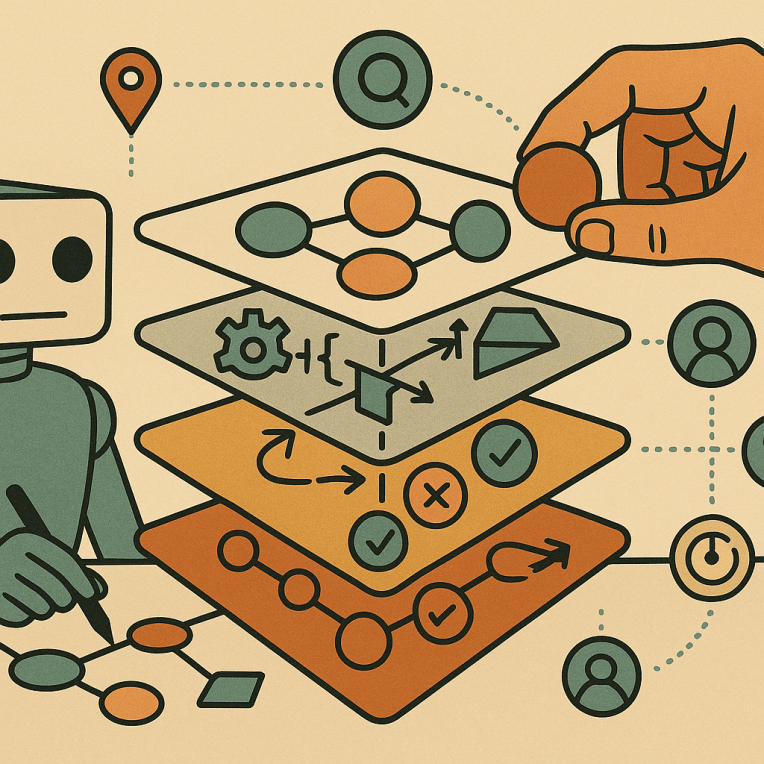What is a Theory Graph?
What is a Theory Graph ← you are here
A Theory Graph is a structured, inspectable map of a research programme.
It organises the components of scientific reasoning, constructs, measures, models, claims, and evidence, as discrete elements (nodes) connected by meaningful relationships (edges). It shows how ideas depend on each other, how they evolve, and how they are tested.
The goal is not to replace theory with diagrams, but to make theory explicit, portable, and revisable.
Why Theory Needs a Graph
Scientific knowledge is built from heuristics: tractable simplifications that work under known limits. These approximations—models, measures, assumptions—are often revised, repurposed, or extended, but rarely made fully legible. Theories change by reframing problems and reorganising constructs, not just by accumulating results.
A Theory Graph captures that structure. It doesn’t just say what we found—it records:
what we assumed
what we meant by key concepts
what models used those concepts
what claims those models implied
what evidence supported or challenged them
and what changed over time
This makes reasoning auditable, refutable, and reusable.
Core Elements
Each node in a Theory Graph represents a unit of reasoning, with metadata: definition, scope, provenance, and status (active, restricted, or retired).
Node Types
Construct – a defined concept (e.g., temporal synchrony)
Measure – an operationalisation of a construct (e.g., overlap between feasible travel times and service hours)
Model – a formal structure linking inputs to outputs (e.g., an access equation with a synchrony weight)
Claim – a testable, scoped statement (e.g., “For night-shift workers, span improves access more than speed”)
Evidence – a dataset or result with methods, scope, and test outcome
Context – the domain, population, place, or timeframe relevant to a node
Edge Types
uses / depends_on (model → construct or measure)
operationalises (measure → construct)
predicts (model → claim)
supported_by / refuted_by (claim → evidence)
extends / restricts / transforms_to / contradicts (between models or claims)
scoped_by (any node → context)
analogous_to (for reuse across domains)
Optional:
Function – an equation or code implementing the model
Prediction – a pre-registered, falsifiable output of the model
Layers and Lineage
Theory Graphs can be read across layers:
Conceptual layer – constructs and relationships
Mathematical layer – equations or algorithms
Version layer – how models evolve or diverge
Empirical layer – what was predicted, tested, and found
Every change (e.g., adding a construct or retiring a claim) is recorded explicitly, with a reason and scope. This supports cumulative science, not “overwrite and forget.”
Example: Synchrony in Transport Access
Suppose a city speeds up buses. Commute times drop, but job access barely improves for night-shift workers. Residuals cluster by time-of-day and occupation.
Triage suggests a missing dimension. We hypothesise a new construct: temporal synchrony—the overlap between a traveller’s available time, destination hours, and transit service availability.
Graph Fragment
Construct
Temporal synchrony (Yij): the intersection (
∩) of personal, destination, and service windows.
Measure
Yij=∣Wi∩Aj∩Sij∣∣Wi∣,where Wi is the traveller’s window, Aj is the destination’s, Sij is service availability.
Model (variant)
Access (Ai) model with synchrony weight:
Ai=∑j1[tij≤T]⋅Yij⋅Oj
Claim
For night-shift workers, access improves more with extended span or reliability than with modest speed increases.
Evidence
Before/after data on night span improvements; residuals by shift; weekend replication.
Edges
Model uses Construct and Measure
Model predicts Claim
Claim supported_by Evidence
Construct analogous_to appointment compatibility (clinics) and dock scheduling (freight)
What Theory Graphs Make Possible
Accountability: Every result points back to the assumptions, constructs, and models that generated it.
Modularity: Concepts and models can be reused or modified without collapse.
Portability: Construct-level analogy supports reuse across domains (e.g., synchrony in freight, retail, clinics).
Revision tracking: Scientific progress is represented as structural change: extending, replacing, or retiring parts of a theory.
Prediction registration: Falsifiable expectations are tied to specific models and tracked through evidence.
How to Start
Pick one project or paper.
Create 10–20 nodes: 2–3 constructs, 1–2 models, 3–5 claims, several measures and evidence points.
Add links: uses, predicts, supported_by, scoped_by, extends.
Note what would cause you to retire each model or claim.
When new evidence arises, update the graph rather than just revising prose.
Summary
A Theory Graph is not a visualisation for its own sake.
It is a working memory for research programmes. It shows what changed, what was tested, and what matters. It invites refutation, enables reuse, and supports theory-building as an open, modular, heuristic practice.
Where a paper says “We found...” a Theory Graph can say “Here’s what that means, how we got there, and what would make us change our minds.”


